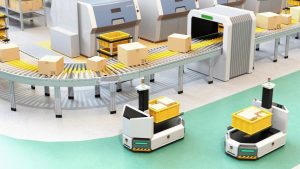Japan stands as a global leader in advanced manufacturing and robotics, home to some of the world’s most innovative companies in these fields. As of 2022, Japanese manufacturers produced or designed approximately 45% of all industrial robots globally, a testament to the country’s pioneering role in automation technology. The record-breaking orders for industrial robots, amounting to $7.35 billion in 2022, reflect a growing commitment to integrating advanced manufacturing technologies across various sectors. This article delves into the trends, benefits, and future prospects of Japan’s advanced manufacturing and robotics landscape.
Japan Advanced Manufacturing Technology Trends 2024

The advanced manufacturing sector in Japan is characterized by a strong emphasis on automation and robotics. With the increasing need for efficiency and productivity, companies are investing heavily in innovative technologies. The shift toward automation is particularly pronounced in industries such as logistics, food processing, and pharmaceuticals, where the demand for streamlined operations is critical.
Current Trends
Increased Automation:
The adoption of advanced robotics in manufacturing processes is at an all-time high. This trend is driven by the need for precision and consistency, which robots can deliver more reliably than human labor. For example, factories in the automotive sector have implemented robotics to automate assembly lines, resulting in faster production rates and fewer defects.
Integration of AI and Machine Learning:
Advanced manufacturing technologies are increasingly incorporating artificial intelligence (AI) and machine learning. These technologies enable robots to learn from their environment and improve their performance over time. An example of this can be seen in the implementation of AI-driven robots in semiconductor manufacturing, where precision is paramount.
Sustainability Initiatives:
With Japan’s commitment to carbon neutrality, many manufacturers are adopting green technologies. This includes energy-efficient machinery and sustainable practices that minimize waste and reduce environmental impact. For instance, companies are investing in electric vehicles (EVs) and related technologies as part of their manufacturing processes.
Industrial Robotics Adoption in Japan for Logistics

As Japan faces acute workforce shortages, the need for efficient logistics solutions has become increasingly pressing. The logistics sector is embracing automation to overcome these challenges, with robotics playing a central role.
Benefits of Robotics in Logistics
Increased Efficiency:
Automated robots can perform tasks such as picking, packing, and sorting goods much faster than human workers. This efficiency leads to shorter delivery times and increased throughput.
Cost Savings:
While the initial investment in robotics may be high, the long-term cost savings are significant. Robots reduce labor costs, minimize errors, and can operate continuously without breaks, leading to a faster return on investment.
Enhanced Safety:
In warehouses and distribution centers, robots can handle heavy lifting and hazardous materials, reducing the risk of workplace injuries. This focus on safety is crucial in maintaining a productive workforce.
Real-World Examples
One notable example of robotics adoption in logistics is the use of autonomous mobile robots (AMRs) in warehouses. Companies like Toyota Industries and Fanuc are leading the charge by integrating AMRs into their operations. These robots navigate complex warehouse environments, transporting goods efficiently and effectively.
Japan’s Market for Automation in Packaging and Transport
The packaging and transport sectors are also experiencing significant advancements due to automation. The integration of robotics into these processes is transforming how goods are packaged, labeled, and transported.
Benefits of Automation in Packaging and Transport
Precision and Consistency:
Automated packaging systems ensure that products are packaged consistently, reducing the risk of errors that can occur with manual processes.
Scalability:
As demand fluctuates, automated systems can easily scale operations up or down, allowing companies to respond quickly to market changes.
Data Collection and Analysis:
Automated systems can collect valuable data on packaging processes, enabling manufacturers to analyze performance and identify areas for improvement.
Case Study
A prominent example of automation in packaging is the collaboration between Seiko Epson Corporation and several leading manufacturers to develop state-of-the-art packaging solutions. Their automated systems are designed to handle everything from food packaging to electronics, ensuring high efficiency and minimal waste.
Impact of Workforce Shortages on Japanese Manufacturing

Japan’s aging population presents significant challenges for the workforce, driving the need for advanced manufacturing technologies. The country’s workforce has declined by more than 2.7 million in the past decade, and projections indicate a potential 40% decrease by 2065.
Addressing Workforce Shortages
- Robotics as a Solution: With a decreasing labor pool, manufacturers are increasingly turning to robotics to maintain productivity. Robots can fill gaps left by human workers, ensuring that production continues unabated.
- Enhanced Training: Companies are also investing in training programs to equip existing workers with the skills needed to operate advanced manufacturing technologies, bridging the gap between human labor and automation.
Government Support for Advanced Manufacturing in Japan
The Japanese government plays a crucial role in fostering innovation in the manufacturing sector. In its fiscal year 2023 budget, the government allocated $39.3 billion to support supply chain resiliency and the upgrading of manufacturing facilities.
Benefits of Government Support
- Subsidies for Technology Upgrades: Manufacturers can apply for government subsidies to modernize their equipment, enabling them to remain competitive in a rapidly changing market.
- Investment in Research and Development: Government support encourages innovation by funding research and development initiatives, paving the way for groundbreaking technologies in manufacturing.
Example of Government Initiatives
The “Manufacturing Innovation Strategy” launched by the Japanese government aims to enhance competitiveness in the manufacturing sector. This initiative encourages collaboration between academia, industry, and government to develop cutting-edge technologies.
Digital Infrastructure Investment in Japan’s Manufacturing Sector
As part of its growth strategy, Japan’s manufacturing sector is expected to invest significantly in digital infrastructure. Companies are estimated to spend $4.1 billion on digital infrastructure by 2030, up from below $1 billion currently.
Benefits of Digital Infrastructure
- Improved Connectivity: Enhanced digital infrastructure enables real-time communication between machines, improving coordination and efficiency in manufacturing processes.
- Data-Driven Decision Making: Companies can leverage data analytics to gain insights into their operations, leading to informed decision-making and optimized processes.
- Enhanced Cybersecurity: As manufacturing becomes more digital, robust cybersecurity measures become essential to protect sensitive data and systems from cyber threats.
Real-World Application
Companies like Hitachi and Fujitsu are leading the way in digital transformation within the manufacturing sector. They are developing advanced systems that integrate IoT (Internet of Things) technologies, enabling manufacturers to monitor and control their processes remotely.
Trade Opportunities for U.S. Companies in Japan’s Robotics Market

The growing demand for advanced manufacturing technologies in Japan presents lucrative opportunities for U.S. solutions providers. Partnering with local agents or distributors can be a key strategy for success.
Benefits of Collaborating with Local Partners
- Access to Established Networks: Local partners possess invaluable market knowledge and established relationships, enabling U.S. companies to navigate the Japanese market more effectively.
- Cultural Insights: Understanding cultural nuances is crucial for success in Japan. Local partners can provide insights into consumer behavior and preferences.
- Streamlined Market Entry: Collaborating with established firms can expedite the market entry process, allowing U.S. companies to launch their products and services more efficiently.
Example of Successful Partnerships
Several U.S. robotics companies, including Boston Dynamics and Universal Robots, have successfully entered the Japanese market by collaborating with local distributors. These partnerships have facilitated the introduction of innovative robotics solutions tailored to meet Japanese industry needs.
Factory Innovation Week 2024: A Platform for Advancement
Scheduled for January 24-26, 2024, Factory Innovation Week in Tokyo is a significant event for industry professionals. Co-located with other shows like Nepcon Japan and Smart Logistics Japan, it serves as a platform for networking and showcasing the latest advancements in manufacturing and robotics.
Benefits of Participating in Factory Innovation Week
- Networking Opportunities: Attendees can connect with key industry players, potential partners, and customers, fostering collaboration and innovation.
- Exposure to Cutting-Edge Technologies: The event showcases the latest technologies in manufacturing and robotics, allowing participants to stay updated on industry trends.
- Workshops and Seminars: Factory Innovation Week features educational sessions that provide insights into best practices and emerging trends in advanced manufacturing.
Final Thought
Japan’s advanced manufacturing and robotics market is a dynamic and rapidly evolving landscape, driven by technological advancements and a pressing need to address workforce challenges. As the country invests in automation and digital infrastructure, the opportunities for innovation and collaboration are immense. U.S. companies looking to enter this market should consider strategic partnerships and stay abreast of the latest trends and developments.
By embracing the future of manufacturing, businesses can contribute to Japan’s ongoing journey towards enhanced productivity, sustainability, and technological leadership in the global arena.




